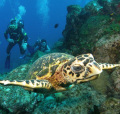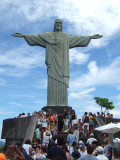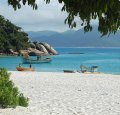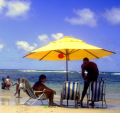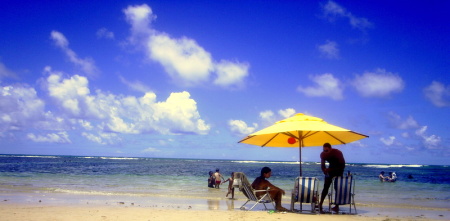
There are few places in the world where you can enjoy such a variety of experiences from one day to the next. Enjoy twelve months of summer on breathtakingly beautiful beaches. Bathe and relax in the natural lagoons created by reefs along large stretches of the palm tree-lined coast, or get an adrenalin rush if you like surfing, diving, snorkeling and other water sports. For history and culture lovers, Recife and nearby Olinda are a must. They were among the first cities established by Portuguese and Dutch colonizers in the early 16th century and much of the Colonial architecture remains, especially in Olinda, a UNESCO World Heritage site. Recife, Olinda and Porto de Galinhas all offer great bars, nightlife and world class gastronomy. Long histories and rich cultures are also reflected in many events and festivals throughout the year. The most famous of course is Carnival, usually celebrated in February or March each year.
Do Not Miss
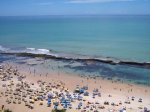 Boa Viagem beach is one of the most impressive urban beaches in Brazil. It can best be enjoyed on weekdays when it is quieter, and at low tide when reefs along parts of the beach create natural lagoons. Signs warning of shark attacks should be taken seriously, but the lagoons at low tide are very safe.
Boa Viagem beach is one of the most impressive urban beaches in Brazil. It can best be enjoyed on weekdays when it is quieter, and at low tide when reefs along parts of the beach create natural lagoons. Signs warning of shark attacks should be taken seriously, but the lagoons at low tide are very safe.  The historic city of Olinda was made a UNESCO World Heritage site in 1982. The colorful Colonial houses, churches and cobblestone streets add to the history and charm of a place that is today home to many artists and artisans. The city also hosts one of the best and most authentic Carnival parties in Brazil.
The historic city of Olinda was made a UNESCO World Heritage site in 1982. The colorful Colonial houses, churches and cobblestone streets add to the history and charm of a place that is today home to many artists and artisans. The city also hosts one of the best and most authentic Carnival parties in Brazil.  Carneiros beach is one of the most unspoiled in Brazil. The area has long expanse of palm tree lined beaches and shallow warm waters that offer ideal bathing conditions. There are also natural pools within the reefs, excellent for snorkeling and teaming with tropical fish that feed from your hand.
Carneiros beach is one of the most unspoiled in Brazil. The area has long expanse of palm tree lined beaches and shallow warm waters that offer ideal bathing conditions. There are also natural pools within the reefs, excellent for snorkeling and teaming with tropical fish that feed from your hand.
Other Top Attractions
 Recife Antigo island was the birthplace of the city, established by Dutch who invaded in 1637. It has rich and interesting architecture, which is being gradually restored. By day it is a business district, but at night it comes alive, especially on weekends when Carnival bands rehearse. Also on Sunday the main street, Rua Bom Jesus, has a street craft market. The same street is home to the oldest synagogue in the Americas.
Recife Antigo island was the birthplace of the city, established by Dutch who invaded in 1637. It has rich and interesting architecture, which is being gradually restored. By day it is a business district, but at night it comes alive, especially on weekends when Carnival bands rehearse. Also on Sunday the main street, Rua Bom Jesus, has a street craft market. The same street is home to the oldest synagogue in the Americas.  Porto de Galinhas is one of the most famous beaches in the area. The beach itself is spectacular, but the town is now very commercial. Nearby are Muro Alto and Macarapaípe beaches, which are both spectacular. It is worth hiring a buggy for a day to go beach hopping from "Porto" as the locals call Porto de Galinhas.
Porto de Galinhas is one of the most famous beaches in the area. The beach itself is spectacular, but the town is now very commercial. Nearby are Muro Alto and Macarapaípe beaches, which are both spectacular. It is worth hiring a buggy for a day to go beach hopping from "Porto" as the locals call Porto de Galinhas.  Downtown Recife is close to Recife Antigo. It is the heart of the city still with a mix of historic churches, building, markets, and squares. Most of the area is off the beaten track as far as foreign tourists are concerned, but for the adventurous tourist it is a must. Hear are the real sights, sounds and smells of the city with all the hustle and bustle.
Downtown Recife is close to Recife Antigo. It is the heart of the city still with a mix of historic churches, building, markets, and squares. Most of the area is off the beaten track as far as foreign tourists are concerned, but for the adventurous tourist it is a must. Hear are the real sights, sounds and smells of the city with all the hustle and bustle. 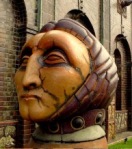 Oficina Francisco Brennand is the workshop and gallery complex of one of Brazil's most important artists. Brennand is a sculptor and painter, the son of a wealthy industrialist who made commercial ceramics. He has been described as the Salvador Dahli of Brazil. His work, both natural and surreal, can be seen in themed water gardens and in the old factory where tiles are also still made.
Oficina Francisco Brennand is the workshop and gallery complex of one of Brazil's most important artists. Brennand is a sculptor and painter, the son of a wealthy industrialist who made commercial ceramics. He has been described as the Salvador Dahli of Brazil. His work, both natural and surreal, can be seen in themed water gardens and in the old factory where tiles are also still made.  Calhetas is a small picturesque beach in a cove very close to Recife. The bay and the rocky outcrops are charming, the waters crystal clear. There are also several bars and restaurants offering fresh seafood.
Calhetas is a small picturesque beach in a cove very close to Recife. The bay and the rocky outcrops are charming, the waters crystal clear. There are also several bars and restaurants offering fresh seafood.
Accommodations

Hotel 7 Colinas, Olinda
There are accomodations of every type and quality in the region, from a luxury beach bungalow with its own pool to a charming old pousada (guesthouse) in the historic city of Olinda or a modern luxury beach front hotel. For full details see our listing of Accommodations by category:
Tours
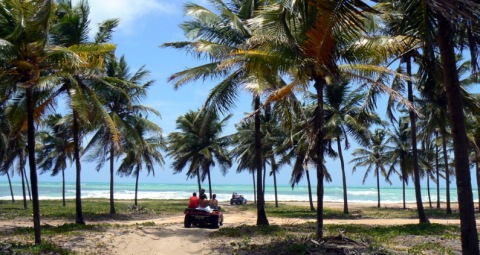
Walking Tours of Recife and Olinda are a great way to soak up the history and culture of the cities' past and a comfortable way to experience authentic city life. They are given by guides who have a real knowledge of the cities.
Day Tours from Recife will help you get to know the real Brazil and enjoy many authentic experiences. They will take you to the beach, the countryside plantations or to historic towns and villages.
Short Adventures are 2-4 day themed itineraries. Like Day Tours, they are designed to show you the real Brazil, past and present. Some are also designed to explore its history and wildlife, or to experience the many sports and activities it offers.
Top 5 Bars

Bar da Praia, Boa Viagem
Bar da Praia is the best bar in Aveneida Boa Viagem. This relatively new bar quickly established itself as the best beach bar. The design, atmosphere and food are all excellent. It is also close to several top restaurants, so a good choice for pre-dinner drinks and happy hour. The avenue has several other good bars described in our bar listing.
Biruta One of the few good bars located right on the beach in Pina at the far end of Aveneida Boa Viagem. A large open terrace overlooks the ocean for great views at night and especially on the night of a full moon. It also has a large selection of seafood dishes and snacks.
Casa da Moeda is run by local photographer and artist Sergio Altenkirch and has a Bohemian feel that attracts a loyal clientele of local artists, writers, and journalists. This “alternative” crowd adds to the atmosphere. It is a great place to drink and snack, also to enjoy the frequent live music performances which vary from jazz and blues to rock, with the occasional performance of Brazilian sounds such as Chorinho (the weeping guitar).
Bar Central is in Downtown Recife. A small, friendly, professionally-run bar that attracts a loyal group of regulars that are described as the alternative crowd – musicians, artists, writers, poets. Also gay and lesbian friendly. One wall is decorated with a large areal map of Recife; other areas have old photographs. The juke box has a great selection of Brazilian and international music. The food is also good with a selection of Brazilian and international snacks and full dishes.
Buraco do Sargento is in one of the most interesting historic squares of the Downtown area. Tables spill out into the cobblestone square which is dominated by the São Perdro church. The square is surrounded by bars that mostly serve traditional regional dishes and snacks for very good prices. This is a place that locals come to after work. It is not a regular tourist haunt. It is a lot less sophisticated, but more authentic and charming, than some large bars in the rich neighborhoods, which are relatively expensive.
For a listing of all bars by area see Bars in Recife
Top 7 Restaurants

Restaurant É, Chef Douglas Van Der Ley
É is a world class restaurant owned by one of Brazil´s top chefs. Douglas Van Der Ley is a genius in the kitchen, a really creative artist who mixes fine international ingredients with Brazilian flavors in exotic combinations that are exquisitely presented. The menu experimentale can be requested and highly recommended it if you want an evening of gastronomic extravagance. É is a restaurant we cannot recommend highly enough!
Spettus is the best restaurant in Recife for meat. In addition to the excellent meat selections, this restaurant serves an extensive cold buffet of salads, vegetable and cheeses – a meal in itself. At twice the price of its nearest rivals, it has had to establish a similar gap in terms of quality.
La Cuisine is a French restaurant which consistently serves a high quality menu within all three areas of the restaurant, each with a distinctive atmosphere: Brasserie, Meditarinian beach restaurant and serious gastronomic restaurant. It is perfect for brunch or lunch (soups, salads, sandwiches, and wraps) or dinner.
Bargaço Fish and other seafood prepared in every imaginable way is a highlight of this restaurant. The quality is consistently high earning Bargaço an enviable reputation that has already lasted many years. For visitors to the city who love fish and seafood, Bargaço is a must.
Parraxaxá The name is of indigenous origin and is pronounced pahashasha. This very popular self-service (pay by the kilo) restaurant serves regional cuisine in a rustic theme restaurant. A very wide selection of savory and sweet dishes. The plates are massive, so make sure your eyes are not bigger then your stomach or it will cost you!
Oficina do Sabor is considered a “must” by most tourists. This restaurant specializes in exotic seafood dishes served in a pumpkin. Most dishes can be shared between two people, making it just about affordable for travelers on a budget. Get there early for a good table with a great view of Recife.
Maison do Bonfim Here you will find traditional French cuisine with a Brazilian flair. The restaurant consistently achieves positive reviews, but despite the excellent reputation, remains relatively affordable. Readers of Recife Guide have all given excellent reports to date.
For a Listing of all restauraunts see:
Nightlife

NOX, Boa Viagem
Nightlife in the region varies a lot by area. In all areas, there are many bars. Most are open until the last customer leaves, especially at weekends. In several, live music can be enjoyed on most nights, especially in the smaller neighborhood bars and in Recife Antigo. As for clubs, the majority are in Boa Viagem. For full details see our listings see Nightlife in Recife
Events

Carnival. Photo: Prefeitura of Olinda
Carnival is the most important annual event to which we have dedicated a section of the site. There are also a large number of other annual cultural events and festivals of music, dance and cinema. The other annual events and one-off events will be listed in the Event Agenda
Info

When you are travelling as an independent traveller you are going to need a lot of information. Recife Guide will give you as much as we can in two seperate A-Z Lists: Basic Information and Advice (coming soon).
Getting There

Recife International Airport (REC)
Recife International Airport (REC), also known as Gilberto Freyre International Airport is a very modern airport with all the facilities you might expect.
It is the main means of Arrival to the State of Pernambuco, and the connection point for most other destinations within the state, although some visitors to Fernando de Noronha may connect via Natal International Airport.
Recife airport is located very close to the city. It is just 1 km from Boa Viagem beach and 9 km from downtown Recife. the distance to Olinda is approximately 15km and to Porto de Galinhas approximately25km.
- Real time arrival and departure information is available from Skyscanner
- For information about buses and taxis serving the airport see our page on Ground Transportation
- To call the airport: (81) 3322 4685 / 3232 4188
 Friday, February 5, 2010 at 03:54PM
Friday, February 5, 2010 at 03:54PM 